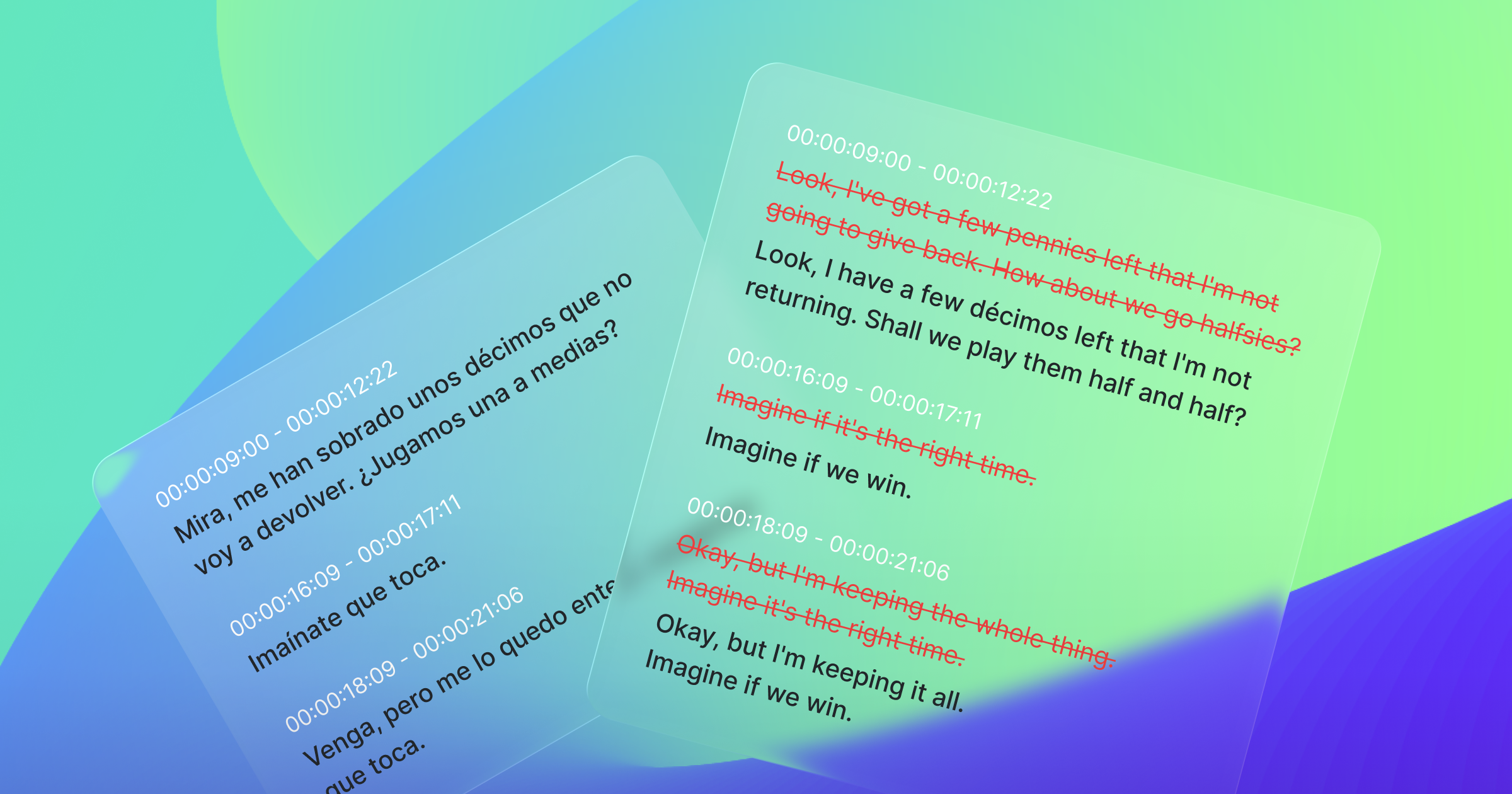Since its launch in 2022, MediaCAT developed by XL8 has been committed to developing features that enhance the efficiency of localization projects while maintaining the highest standards of quality. Efficiency in localization can be viewed from two perspectives: project management by the project managers and the editing and quality control tasks performed by linguists.
According to the paper "The quality and productivity of post-edited machine translation in comparison with human translation : A case of Korean-English legal translation" from Department of Interpreting & Translation Ewha Womans University, “The analysis indicated the superiority of post-edited machine translation both in terms of quality and productivity. Compared with human translation, post-editing improved the average number of processed words by about 20%, while significantly reducing technical efforts." Undoubtedly, employing appropriate tools for specific tasks significantly enhances work efficiency.
Today, we will explore the features within MediaCAT that are tailored to assist linguists in achieving optimal efficiency and maintaining high quality standards.
1. Translation Memory & Term Base QC

Maintaining consistent terminology and phrasing throughout a project is paramount to delivering high-quality localized content, particularly in the context of serialized media localization projects. To empower linguists with the tools necessary to uphold consistency, MediaCAT has pioneered the integration of Translation Memory (TM) and Terminology Base (TB) files into its media localization workflow.
MediaCAT enables users to upload and leverage .TMX and .TBX files. Then, during the project creation process, users can effortlessly apply these files, ensuring that the localized content adheres to established terminology and phrasing conventions. Once applied to a project, MediaCAT's advanced subtitle editor seamlessly displays a real-time comparison between the subtitle content and the uploaded TM and TB files. This innovative feature visualizes differences and provides matching percentage scores for easy reference.
Currently, MediaCAT is in the initial stage of integrating Translation Memory & Term Base features into the media localization domain. In the upcoming phases, our team plans to introduce a feature allowing users to create and manage Translation Memory files directly within MediaCAT.
2. AI Powered QC
Recognizing the importance of streamlining post-editing efforts for linguists, MediaCAT's advanced subtitle editor is equipped with capabilities to identify and flag sentences with potential uncertainties, enhancing efficiency in both speech-to-text (STT) and machine translation (MT) workflows.

For STT accuracy detection, MediaCAT's AI-powered engine is adept at recognizing challenging audio conditions, such as loud background noise or overlapping dialogues, where STT results may be less reliable compared to optimal scenarios. This proactive approach ensures that linguists are promptly alerted to segments that may require additional attention.

Similarly, for MT output, the subtitle editor employs sophisticated AI algorithms to detect translation uncertainties that exceed a predefined threshold. This intelligent filtering mechanism empowers linguists to focus their efforts on segments that may require further refinement, maximizing their productivity.
In both STT and MT workflows, MediaCAT's intuitive user interface seamlessly integrates warning icons that prompt users to review specific segments flagged for potential inaccuracies. Moreover, this robust quality assurance measure is seamlessly integrated into the validation workflow, ensuring that potential errors are comprehensively reviewed by linguists before completing their assignments.
3. Audio-Visual Speaker Diarization
MediaCAT has achieved an industry-leading accuracy rate by pioneering a groundbreaking approach that seamlessly integrates audio analysis with advanced visual data processing techniques, including facial recognition and lip movement detection.

Enhanced Speaker Diarization (ESD) feature can be effortlessly accessed through the Advanced Settings during the Sync creation process. It's important to note that enabling ESD typically requires processing time approximately double the video's runtime. However, the benefits of this innovative approach are substantial, as linguists can leverage unparalleled accuracy in speaker identification once the Sync process with ESD is complete.
Moreover, MediaCAT's intuitive editor interface streamlines the speaker editing workflow, empowering linguists to refine speaker assignments with ease. By combining exceptional diarization accuracy with a user-friendly editing experience, MediaCAT ensures that linguists can focus their efforts on delivering impeccable localized content, free from the constraints of manual speaker assignment and verification.
4. Automatic Glossary Generation
XL8's proprietary Machine Translation (MT) engine boasts an impressive accuracy rate exceeding 95% for selected language pairs. This remarkable feat is achieved through our unwavering commitment to continuously training the engine with meticulously curated and domain-specific data tailored to the media and entertainment industry. While our MT engine is uniquely trained and regularly updated to maintain its cutting-edge performance, certain words or phrases may still pose challenges, whether due to unique spellings or unusual interpretations.

To address this, MediaCAT's powerful glossary function empowers users to create custom .csv files containing words or phrases that may be unique, such as proper names or specialized terminology. Additionally, we offer an advanced AI-driven automatic glossary generation tool, enabling users to leverage keywords related to their specific project. This versatile feature allows users to refine their glossary generation by providing contextual details, such as "Character list for the series, FRIENDS" or "commonly used phrases by characters in the series FRIENDS," ensuring the resulting glossary is tailored to their project's unique requirements.
Once generated, these glossaries can be seamlessly integrated into two crucial aspects of the localization workflow. First, they can be applied during the Sync process, aiding in capturing accurate spellings and word identification for speech-to-text tasks. Second, glossaries can be leveraged during the Translate stage, ensuring that the original language source and the preferred translated word or phrase are accurately captured and maintained throughout the localization process.
By combining our industry-leading MT engine with this powerful glossary functionality, MediaCAT empowers its users with a comprehensive suite of tools to achieve unparalleled accuracy, speed and consistency in their localization projects.
5. STT & MT Output Formatting Options
XL8's proprietary engines showcase an impressive accuracy rate exceeding 95% for selected languages, both in automatic transcription and translation tasks. While this industry-leading accuracy is a testament to our commitment to innovation, we recognize that AI-generated results invariably require post-editing by skilled linguists. Driven by our unwavering dedication to maximizing efficiency, our team has developed a suite of features designed to streamline the human editing process.

One such feature is the ability to customize output formatting options for both Sync and Translate workflows. During the project creation process, users can define a set of rules, known as 'validation guidelines' within MediaCAT, for the engines to follow. These guidelines encompass specifications such as the maximum number of lines per subtitle segment, maximum characters per line, and minimum and maximum duration of subtitle events. Users have the flexibility to create multiple templates, ensuring that these guidelines can be tailored to the unique requirements of different projects.
By providing Validation Guides, users can leverage a significant advantage: the post-editing process begins with a file that already meets most of the technical requirements. This proactive approach greatly reduces the time and effort required to navigate through the file, enhancing overall efficiency and productivity.
In this article, I introduced five features that translators can utilize to maximize their efficiency when translating video subtitles using MediaCAT's editor—a localization tool equipped with cutting-edge AI technology.
In the following post, I'll share how you can expedite the entire localization post-production process by transcribing, translating, and localizing dubbing and voice-overs in just a few clicks on the MediaCAT platform.
The features we're exploring today are free to try following a simple signup. Let's discuss how XL8 can enhance the efficiency of your localization projects and save your time to manage them. Contact MediaCAT Product Manager!










